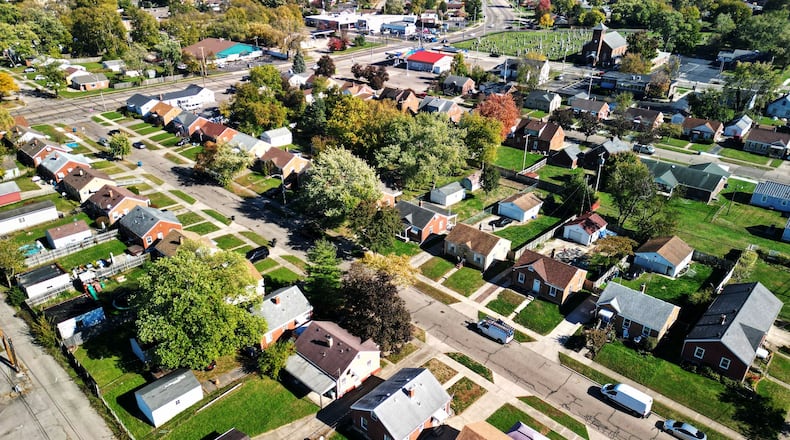“It perhaps took a push like it often does for something extraordinary to get something extraordinary done, this is a big deal,” Huffman added. “As a result of these things over the next three years there’s going to be $2.4 billion less paid which is about a 10% cut, that’s significant.”
The bills are designed to prevent unvoted property tax spikes people have had to pay over the last five years, due to a host of factors, some of them pandemic related and others due to lawmakers tinkering with school funding and other tax laws through the years.
Statehouse conversations touching property taxes these days invariably turn to the grassroots group from Cuyahoga County, Citizens for Property Tax Reform, that is attempting to put a constitutional amendment to eliminate property taxes entirely on the statewide November 2026 ballot.
Their spokeswoman Beth Blackmarr told this media outlet for “strategic” reasons they will not reveal how many petition signatures they’ve collected — they’ve been gathering since May and need roughly 600,000 — but they have signing stations in 63 counties and circulators statewide. The filing deadline is July 1, 2026.
As for the reform measures the House is touting, she said her tax bill jumped 51.9% and these bills won’t fix that.
“What they’re doing now is a stop gap to keep from hitting us harder. We’re already hit and the real estate market is flattening, so how does this help us,” she said and later added. “Some of the stuff they’re saying just doesn’t jive and some of moves they’re making, they’re like it’s $2.7 billion over three years, well big deal, that’s like three percent.”
Blackmarr said while she isn’t impressed with the effort so far, a Senate bill that just emerged from a dormant state — it’s been sitting on the shelf of unheard bills since May — could convince voters not to vote for their ballot initiative.
Senate Bill 206 — with an estimated $1.5 billion price tag — would pay up to 50% of the property tax bills for homeowners age 65-plus, regardless of income. She said it would be “significant, that would help tremendously, I hope this thing makes it because people are looking for relief, immediate relief.”
The measure was introduced by Sen. Al Cutrona, R-Canfield, and heard for the first time by the Senate Ways and Means Committee on Tuesday.
Senate Ways and Means Committee Chairman Bill Blessing, R-Colerain Twp., told this news outlet he knows the bill won’t pass — he thinks the $1.5 billion estimate is light — but he typically gives everyone a first hearing. There won’t likely be a second.
This media outlet has been keeping tabs on all property tax related bills introduced in the past couple years. Of the 44 bills introduced this year 19 haven’t had hearings yet and a dozen have only been heard once. There are 19 bills that would require state funding that range in cost — a dozen haven’t been estimated yet — from $3 million up to the aforementioned $1.5 billion bill.
There are 11 measures that put the onus for funding reform on local entities that range from $89 million up to $1.7 billion. The rest don’t really have calculable costs. So far six bills have been approved by the House and moved to the Senate.
A couple measures have become law through the budget process. Eliminating certain types of levies was in the biennium budget, vetoed by the governor and recently enacted through a veto override. Allowing counties to provide “piggyback” Homestead exemptions and the 12.5% tax rollbacks was never in a bill but is now law. According to a tracker by the County Commissioners Association of Ohio roughly 13 counties have enacted piggyback benefits and or inside millage rollbacks.
Senate Finance Committee Chairman Jerry Cirino, R-Kirtland, said they are working toward passing a “pretty comprehensive bill or set of bills” hopefully before Thanksgiving.
As for bills that cost the state big money, they are not in the budget and “we don’t have billions of dollars sitting around waiting to be appropriated.” Even before Gov. Mike DeWine signed an executive order authorizing $25 million for needy families losing their SNAP benefits, Cirino told this news outlet funding property tax reform would be difficult because the federal “Big Beautiful Bill” will impact the states financially.
“If there’s going to be additional appropriations someone’s got to figure out where the money’s going to come from,” he said. “I know running Finance Committee in the Senate we don’t have money sitting around, in fact it’s the opposite direction, we have some really potential liabilities coming forward that we have to figure out what to do with it.”
Both Blessing and Cirino said the effort to erase property taxes is “irresponsible” because you can’t just wipe out $23.9 billion without a plan to replace it to fund local services.
“Rather than dealing with some of the underlying structural problems we just want to get rid of everything, to me that is entirely unreasonable,” Blessing said. “Suppose they get on the ballot, I think it goes down handily as it has in other Red states when people realize what that effectively means.”
About the Author
